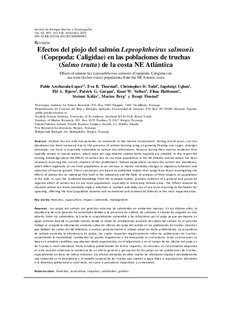| dc.contributor.author | Lopez, Pablo Arachavala | |
| dc.contributor.author | Thorstad, Eva Bonsak | |
| dc.contributor.author | Todd, Christopher D. | |
| dc.contributor.author | Uglem, Ingebrigt | |
| dc.contributor.author | Bjørn, Pål Arne | |
| dc.contributor.author | Gargan, Patrick G. | |
| dc.contributor.author | Vollset, Knut Wiik | |
| dc.contributor.author | Halttunen, Elina | |
| dc.contributor.author | Kålås, Steinar | |
| dc.contributor.author | Berg, Marius | |
| dc.contributor.author | Finstad, Bengt | |
| dc.date.accessioned | 2017-12-14T12:43:59Z | |
| dc.date.available | 2017-12-14T12:43:59Z | |
| dc.date.created | 2015-12-07T15:59:49Z | |
| dc.date.issued | 2015 | |
| dc.identifier.citation | Revista de biologia marina y oceanografia. 2015, 50 (3), 411-426. | |
| dc.identifier.issn | 0717-3326 | |
| dc.identifier.uri | http://hdl.handle.net/11250/2471810 | |
| dc.description.abstract | Salmon lice are external parasites on salmonids in the marine environment. During recent years, sea lice abundance has been increased due to the presence of salmon farming using on-growing floating seas-cages. Amongst salmonids, sea trout is especially vulnerable to salmon lice infestations, because during their marine residence they typically remain in coastal waters, where open net cage Atlantic salmon farms typically are situated. In this report the existing knowledge about the effects of salmon lice on sea trout populations in the NE Atlantic coastal waters has been reviewed, assessing the current situation of this problematic. Salmon aquaculture increase the salmon lice abundance, which affect negatively on sea trout populations as an increase in marine mortality, changes in migratory behaviour and reduction of marine growth. These conclusions are based on published studies that range from those investigating the effects of salmon lice on individual fish, both in the laboratory and the field, to analyses of their impacts on populations in the wild. In sum, the combined knowledge from the reviewed studies provides evidence of a general and pervasive negative effect of salmon lice on sea trout populations, especially in intensively farmed areas. The effects induced by elevated salmon lice levels inevitably imply a reduction in numbers and body size of sea trout returning to freshwater for spawning, affecting the local population dynamic and recreational and commercial fisheries in the most impacted areas. | |
| dc.language.iso | spa | |
| dc.subject | Akvakultur | |
| dc.subject | Aquaculture | |
| dc.subject | Parasitter | |
| dc.subject | Parasiates | |
| dc.subject | Innvirkning | |
| dc.subject | Impact | |
| dc.subject | Anadrome laksefisk | |
| dc.subject | Anadromous salmonids | |
| dc.title | Efectos del piojo del salmón Lepeophtheirus salmonis(Copepoda: Caligidae) en las poblaciones de truchas (Salmo trutta) de la costa NE Atlántica | |
| dc.type | Peer reviewed | |
| dc.type | Journal article | |
| dc.description.version | publishedVersion | |
| dc.subject.nsi | VDP::Zoologiske og botaniske fag: 480 | |
| dc.subject.nsi | VDP::Zoology and botany: 480 | |
| dc.source.pagenumber | 411-426 | |
| dc.source.volume | 50 | |
| dc.source.journal | Revista de biologia marina y oceanografia | |
| dc.source.issue | 3 | |
| dc.identifier.cristin | 1297876 | |
| dc.relation.project | Norges forskningsråd: 243912 | |
| dc.relation.project | Norges forskningsråd: 221404 | |
| cristin.unitcode | 7431,17,0,0 | |
| cristin.unitname | Sykdom og smittespredning | |
| cristin.ispublished | true | |
| cristin.fulltext | original | |
| cristin.qualitycode | 1 | |
